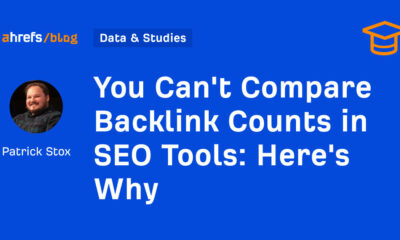MARKETING
Here’s How To Ask for the Salary You Want

Should you be paid more for what you do?
Over half of content marketers (54%) believe their compensation should be higher, according to CMI’s Content Marketing Career and Salary Outlook 2023 (registration required).
And now’s a good time to ask – the latest CMI B2B research found content marketing’s importance in the business has grown.
Of course, it’s also a tricky time to ask, as businesses face higher prices and external economic pressures. As Tom McMullen, senior client partner at Korn Ferry, has said: “This is the most turbulent compensation environment I’ve seen in my 30-year career.”
So how can you move from thinking you deserve a raise to seeing a bigger number on your paycheck? Do your research, prep your case, and present it effectively.
To get the raise you deserve, research #ContentMarketing salaries, pack your case with results, and practice your pitch, says @AnnGynn via @CMIContent. Click To Tweet
Do external research
To prepare to make your case for a salary increase, find out what others in your industry and similar positions earn. CMI’s salary research found the median salary for U.S.-based content marketers who work for an employer is $82,738.
That number is just a starting point. Dig deeper to understand how experience and role affect compensation, too.
CMI’s salary research found salaries vary based on experience, ranging from $51,190 for those with up to seven years of experience to $96,034 for those with more than 15 years of experience.
CMI divided content marketing roles into three categories – hands-on, manager, and high-level. The median salary for hands-on content marketers is $58,790, while at the executive level, the median wage amounts to $111,851.
For more information on salaries specific to your role, explore job listings on platforms like LinkedIn and Indeed.
Another option is to use the salary tool from the recruiting agency Creative Circle. When you select a job title and location, the tool reveals both the average pay and the desired salary based on what candidates say they want. All the data comes from Creative Circle’s clients and job applicants.
Research role-specific salaries on @LinkedIn, @Indeed, or with a salary tool like the one from @Creative_Circle, says @AnnGynn via @CMIContent. Click To Tweet
Get ready internally
With the external benchmark comparisons in hand, you’re ready to look inward. Evaluate two key things: the general business environment and content marketing’s impact on the business.
If your employer is doing well, asking for a raise makes sense. Salary increases may be possible even if your company has been going through layoffs or shrinking staff sizes. But you’ll need to think critically.
If the company isn’t bringing in enough revenue to pay the bills, forget about asking for a raise. If the company is cutting back for a leaner operation and your role has become more critical, it could be a good time to ask for a salary increase.
Now it’s time to do a self-check.
Dominic Lill is an SEO manager at Trafiki Ecommerce who successfully negotiated salary increases in his previous role as a content editor/marketer. He suggests asking yourself these questions:
- Have my responsibilities grown?
- Have I become more productive?
- What areas of my work could I improve? (Anticipating negatives helps you prepare responses to them.)
With that external, internal, and personal research, you’re almost ready to make the ask. But here’s an idea you should consider long before you want the raise.
Build a bench of supporters
Steve Rose, vice president at Intent, offers a tip to help you prepare your case: “Aggressively cultivate your support base. Having someone else advocate for you can go a long way toward demonstrating your value.”
But don’t wait to develop your advocates until you’re ready to ask for the salary bump. “Build these ties proactively over time,” Steve says. “If they’re comfortable, ask one or two of them to send a statement to your boss about your progress and improvement.”
Another helpful approach is to keep your own bullet list-style document where you paste positive feedback, metrics, and results from your work. Then, when you’re ready to argue for a salary increase (or update your resume), pull the most important and relevant bullets into your formal request.
Prepare for the conversation
Even a well-researched request can feel nerve-wracking. “Most people tremble at approaching their boss about a wage boost,” says Vaibhav Kakkar, CEO of Digital Web Solutions.
Think about how you’ll introduce the topic, then rehearse the conversation.
Vaibhav offers this prompt to get you started: “As you’re aware, I just finished my (X) year with (organization). I am eager to continue working toward the company’s goals in my current position and expand my duties. On that basis, let’s talk about my pay.”
Make a specific request within the realistic possibilities. Otherwise, the employer might offer a raise amount lower than you wanted.
Base your requested amount on your earlier research. Think about the actual percentage increase. If you retain the same responsibilities, a 3% raise is typical. “Anything over 5% is remarkable,” Vaibhav says.
If your duties have expanded or the circumstances have changed (i.e., a job with minimal travel becomes a job with 50% travel), a higher rate of 10 to 20% might be possible, he says.
If you retain the same role and responsibilities but your research points to a wide gap between the average standard industry rate and your compensation, plan for a more extensive conversation. The industry gap likely exists for other roles, too. A significant change in your salary likely would lead your employer to need to address other underpaid positions, too.
Your supervisor is unlikely to approve your request during your initial conversation. They may need to revisit their budget, reflect on what you’ve shared, or have a conversation with their boss.
Set follow-up expectations at the end of the conversation, says Adam Crossling, head of marketing at Zenzero. He suggests some language to use: “Is it OK if I check back with you two weeks from now if I haven’t heard anything?”
Aim for yes, but plan for no
Work for a “yes,” but plan for a “no” or “not now.” That way, if you’re told the company doesn’t have the money, you’ll be ready to propose an alternative solution.
Josh Pelletier, chief marketing officer of BarBend, says: “To move up the ranks, you may ask for something other than a pay raise, such as more training or a chance to participate in special projects.”
As Josh explains, “Mortgages are paid with salary, but careers are built on terms. And those are words to live by if your boss is unable to increase your salary.”
To move up the ranks, ask for something other than a pay raise, says @barbendnews CMO Josh Pelletier via @AnnGynn @CMIContent. Click To Tweet
Salary success story
Content marketer Allison Gagliardi asked for 10% raises at two previous employers. Both times, she got a salary bump.
Allison says she made her case to two employers, both internet marketing agencies, in the annual review process.
With her first employer, she had been a content editor for three years and had received the annual 3% raises most everybody received. Then she made her case and received a 10% increase. She took a similar tactic a few years later as a senior content manager at another agency. In her first-year performance review there, she asked for and received a 10% raise.
How did she make the successful presentations? She wrote a letter outlining her compensation request and listed her accomplishments to date in a bullet format. She signed the letter – with an actual pen – and put it in a two-pocket folder. In the other pocket, she included emails/letters from clients and co-workers singing her praises. “It’s proof they just can’t argue with,” Allison says.
Based on her success, Allison offers a few tips for making your presentation:
- Ask for a percent increase vs. a dollar figure. Sometimes a percentage request is “easier on the eyes.”
- Use numbers to impress. Include percentages, hours worked, money saved, people hired, etc.
- Be ready with a consolation prize. Be prepared with a counteroffer such as, “I’m hearing you can’t meet my request this year. I think adding five paid-time-off days to my account is comparable.”
Be creative about your consolation prize suggestions. Allison offers some suggestions: a bonus on achieving a specific benchmark, permission to bring a pet into the office on certain days, a standing desk, an air card (for Wi-Fi wherever you go), an improved title, a continuing education plan, or even control of the AC unit in your department (yes, for real).
If you don’t get the salary you want? Consider moving on. A recent Pew Research Center study found that people who switched jobs were more likely to get real wage increases (after accounting for inflation) than people who stayed with the same employer. And remember, it’s sometimes easier to negotiate a higher offer than a raise.
Are you ready to make your case for a higher salary? Share your success stories and tips in the comments.
HANDPICKED RELATED CONTENT:
Cover image by Joseph Kalinowski/Content Marketing Institute
MARKETING
Ecommerce evolution: Blurring the lines between B2B and B2C

Understanding convergence
B2B and B2C ecommerce are two distinct models of online selling. B2B ecommerce is between businesses, such as wholesalers, distributors, and manufacturers. B2C ecommerce refers to transactions between businesses like retailers and consumer brands, directly to individual shoppers.
However, in recent years, the boundaries between these two models have started to fade. This is known as the convergence between B2B and B2C ecommerce and how they are becoming more similar and integrated.
Source: White Paper: The evolution of the B2B Consumer Buyer (ClientPoint, Jan 2024)
What’s driving this change?
Ever increasing customer expectations
Customers today expect the same level of convenience, speed, and personalization in their B2B transactions as they do in their B2C interactions. B2B buyers are increasingly influenced by their B2C experiences. They want research, compare, and purchase products online, seamlessly transitioning between devices and channels. They also prefer to research and purchase online, using multiple devices and channels.
Forrester, 68% of buyers prefer to research on their own, online . Customers today expect the same level of convenience, speed, and personalization in their B2B transactions as they do in their B2C interactions. B2B buyers are increasingly influenced by their B2C experiences. They want research, compare, and purchase products online, seamlessly transitioning between devices and channels. They also prefer to research and purchase online, using multiple devices and channels
Technology and omnichannel strategies
Technology enables B2B and B2C ecommerce platforms to offer more features and functionalities, such as mobile optimization, chatbots, AI, and augmented reality. Omnichannel strategies allow B2B and B2C ecommerce businesses to provide a seamless and consistent customer experience across different touchpoints, such as websites, social media, email, and physical stores.
However, with every great leap forward comes its own set of challenges. The convergence of B2B and B2C markets means increased competition. Businesses now not only have to compete with their traditional rivals, but also with new entrants and disruptors from different sectors. For example, Amazon Business, a B2B ecommerce platform, has become a major threat to many B2B ecommerce businesses, as it offers a wide range of products, low prices, and fast delivery
“Amazon Business has proven that B2B ecommerce can leverage popular B2C-like functionality” argues Joe Albrecht, CEO / Managing Partner, Xngage. . With features like Subscribe-and-Save (auto-replenishment), one-click buying, and curated assortments by job role or work location, they make it easy for B2B buyers to go to their website and never leave. Plus, with exceptional customer service and promotional incentives like Amazon Business Prime Days, they have created a reinforcing loyalty loop.
And yet, according to Barron’s, Amazon Business is only expected to capture 1.5% of the $5.7 Trillion addressable business market by 2025. If other B2B companies can truly become digital-first organizations, they can compete and win in this fragmented space, too.”
If other B2B companies can truly become digital-first organizations, they can also compete and win in this fragmented space
Joe AlbrechtCEO/Managing Partner, XNGAGE
Increasing complexity
Another challenge is the increased complexity and cost of managing a converging ecommerce business. Businesses have to deal with different customer segments, requirements, and expectations, which may require different strategies, processes, and systems. For instance, B2B ecommerce businesses may have to handle more complex transactions, such as bulk orders, contract negotiations, and invoicing, while B2C ecommerce businesses may have to handle more customer service, returns, and loyalty programs. Moreover, B2B and B2C ecommerce businesses must invest in technology and infrastructure to support their convergence efforts, which may increase their operational and maintenance costs.
How to win
Here are a few ways companies can get ahead of the game:
Adopt B2C-like features in B2B platforms
User-friendly design, easy navigation, product reviews, personalization, recommendations, and ratings can help B2B ecommerce businesses to attract and retain more customers, as well as to increase their conversion and retention rates.
According to McKinsey, ecommerce businesses that offer B2C-like features like personalization can increase their revenues by 15% and reduce their costs by 20%. You can do this through personalization of your website with tools like Product Recommendations that help suggest related products to increase sales.
Focus on personalization and customer experience
B2B and B2C ecommerce businesses need to understand their customers’ needs, preferences, and behaviors, and tailor their offerings and interactions accordingly. Personalization and customer experience can help B2B and B2C ecommerce businesses to increase customer satisfaction, loyalty, and advocacy, as well as to improve their brand reputation and competitive advantage. According to a Salesforce report, 88% of customers say that the experience a company provides is as important as its products or services.
Market based on customer insights
Data and analytics can help B2B and B2C ecommerce businesses to gain insights into their customers, markets, competitors, and performance, and to optimize their strategies and operations accordingly. Data and analytics can also help B2B and B2C ecommerce businesses to identify new opportunities, trends, and innovations, and to anticipate and respond to customer needs and expectations. According to McKinsey, data-driven organizations are 23 times more likely to acquire customers, six times more likely to retain customers, and 19 times more likely to be profitable.
What’s next?
The convergence of B2B and B2C ecommerce is not a temporary phenomenon, but a long-term trend that will continue to shape the future of ecommerce. According to Statista, the global B2B ecommerce market is expected to reach $20.9 trillion by 2027, surpassing the B2C ecommerce market, which is expected to reach $10.5 trillion by 2027. Moreover, the report predicts that the convergence of B2B and B2C ecommerce will create new business models, such as B2B2C, B2A (business to anyone), and C2B (consumer to business).
Therefore, B2B and B2C ecommerce businesses need to prepare for the converging ecommerce landscape and take advantage of the opportunities and challenges it presents. Here are some recommendations for B2B and B2C ecommerce businesses to navigate the converging landscape:
- Conduct a thorough analysis of your customers, competitors, and market, and identify the gaps and opportunities for convergence.
- Develop a clear vision and strategy for convergence, and align your goals, objectives, and metrics with it.
- Invest in technology and infrastructure that can support your convergence efforts, such as cloud, mobile, AI, and omnichannel platforms.
- Implement B2C-like features in your B2B platforms, and vice versa, to enhance your customer experience and satisfaction.
- Personalize your offerings and interactions with your customers, and provide them with relevant and valuable content and solutions.
- Leverage data and analytics to optimize your performance and decision making, and to innovate and differentiate your business.
- Collaborate and partner with other B2B and B2C ecommerce businesses, as well as with other stakeholders, such as suppliers, distributors, and customers, to create value and synergy.
- Monitor and evaluate your convergence efforts, and adapt and improve them as needed.
By following these recommendations, B2B and B2C ecommerce businesses can bridge the gap between their models and create a more integrated and seamless ecommerce experience for their customers and themselves.
MARKETING
Streamlining Processes for Increased Efficiency and Results

How can businesses succeed nowadays when technology rules? With competition getting tougher and customers changing their preferences often, it’s a challenge. But using marketing automation can help make things easier and get better results. And in the future, it’s going to be even more important for all kinds of businesses.
So, let’s discuss how businesses can leverage marketing automation to stay ahead and thrive.
Benefits of automation marketing automation to boost your efforts
First, let’s explore the benefits of marketing automation to supercharge your efforts:
Marketing automation simplifies repetitive tasks, saving time and effort.
With automated workflows, processes become more efficient, leading to better productivity. For instance, automation not only streamlines tasks like email campaigns but also optimizes website speed, ensuring a seamless user experience. A faster website not only enhances customer satisfaction but also positively impacts search engine rankings, driving more organic traffic and ultimately boosting conversions.
Automation allows for precise targeting, reaching the right audience with personalized messages.
With automated workflows, processes become more efficient, leading to better productivity. A great example of automated workflow is Pipedrive & WhatsApp Integration in which an automated welcome message pops up on their WhatsApp
within seconds once a potential customer expresses interest in your business.
Increases ROI
By optimizing campaigns and reducing manual labor, automation can significantly improve return on investment.
Leveraging automation enables businesses to scale their marketing efforts effectively, driving growth and success. Additionally, incorporating lead scoring into automated marketing processes can streamline the identification of high-potential prospects, further optimizing resource allocation and maximizing conversion rates.
Harnessing the power of marketing automation can revolutionize your marketing strategy, leading to increased efficiency, higher returns, and sustainable growth in today’s competitive market. So, why wait? Start automating your marketing efforts today and propel your business to new heights, moreover if you have just learned ways on how to create an online business
How marketing automation can simplify operations and increase efficiency
Understanding the Change
Marketing automation has evolved significantly over time, from basic email marketing campaigns to sophisticated platforms that can manage entire marketing strategies. This progress has been fueled by advances in technology, particularly artificial intelligence (AI) and machine learning, making automation smarter and more adaptable.
One of the main reasons for this shift is the vast amount of data available to marketers today. From understanding customer demographics to analyzing behavior, the sheer volume of data is staggering. Marketing automation platforms use this data to create highly personalized and targeted campaigns, allowing businesses to connect with their audience on a deeper level.
The Emergence of AI-Powered Automation
In the future, AI-powered automation will play an even bigger role in marketing strategies. AI algorithms can analyze huge amounts of data in real-time, helping marketers identify trends, predict consumer behavior, and optimize campaigns as they go. This agility and responsiveness are crucial in today’s fast-moving digital world, where opportunities come and go in the blink of an eye. For example, we’re witnessing the rise of AI-based tools from AI website builders, to AI logo generators and even more, showing that we’re competing with time and efficiency.
Combining AI-powered automation with WordPress management services streamlines marketing efforts, enabling quick adaptation to changing trends and efficient management of online presence.
Moreover, AI can take care of routine tasks like content creation, scheduling, and testing, giving marketers more time to focus on strategic activities. By automating these repetitive tasks, businesses can work more efficiently, leading to better outcomes. AI can create social media ads tailored to specific demographics and preferences, ensuring that the content resonates with the target audience. With the help of an AI ad maker tool, businesses can efficiently produce high-quality advertisements that drive engagement and conversions across various social media platforms.
Personalization on a Large Scale
Personalization has always been important in marketing, and automation is making it possible on a larger scale. By using AI and machine learning, marketers can create tailored experiences for each customer based on their preferences, behaviors, and past interactions with the brand.
This level of personalization not only boosts customer satisfaction but also increases engagement and loyalty. When consumers feel understood and valued, they are more likely to become loyal customers and brand advocates. As automation technology continues to evolve, we can expect personalization to become even more advanced, enabling businesses to forge deeper connections with their audience. As your company has tiny homes for sale California, personalized experiences will ensure each customer finds their perfect fit, fostering lasting connections.
Integration Across Channels
Another trend shaping the future of marketing automation is the integration of multiple channels into a cohesive strategy. Today’s consumers interact with brands across various touchpoints, from social media and email to websites and mobile apps. Marketing automation platforms that can seamlessly integrate these channels and deliver consistent messaging will have a competitive edge. When creating a comparison website it’s important to ensure that the platform effectively aggregates data from diverse sources and presents it in a user-friendly manner, empowering consumers to make informed decisions.
Omni-channel integration not only betters the customer experience but also provides marketers with a comprehensive view of the customer journey. By tracking interactions across channels, businesses can gain valuable insights into how consumers engage with their brand, allowing them to refine their marketing strategies for maximum impact. Lastly, integrating SEO services into omni-channel strategies boosts visibility and helps businesses better understand and engage with their customers across different platforms.
The Human Element
While automation offers many benefits, it’s crucial not to overlook the human aspect of marketing. Despite advances in AI and machine learning, there are still elements of marketing that require human creativity, empathy, and strategic thinking.
Successful marketing automation strikes a balance between technology and human expertise. By using automation to handle routine tasks and data analysis, marketers can focus on what they do best – storytelling, building relationships, and driving innovation.
Conclusion
The future of marketing automation looks promising, offering improved efficiency and results for businesses of all sizes.
As AI continues to advance and consumer expectations change, automation will play an increasingly vital role in keeping businesses competitive.
By embracing automation technologies, marketers can simplify processes, deliver more personalized experiences, and ultimately, achieve their business goals more effectively than ever before.
MARKETING
Will Google Buy HubSpot? | Content Marketing Institute

Google + HubSpot. Is it a thing?
This week, a flurry of news came down about Google’s consideration of purchasing HubSpot.
The prospect dismayed some. It delighted others.
But is it likely? Is it even possible? What would it mean for marketers? What does the consideration even mean for marketers?
Well, we asked CMI’s chief strategy advisor, Robert Rose, for his take. Watch this video or read on:
Why Alphabet may want HubSpot
Alphabet, the parent company of Google, apparently is contemplating the acquisition of inbound marketing giant HubSpot.
The potential price could be in the range of $30 billion to $40 billion. That would make Alphabet’s largest acquisition by far. The current deal holding that title happened in 2011 when it acquired Motorola Mobility for more than $12 billion. It later sold it to Lenovo for less than $3 billion.
If the HubSpot deal happens, it would not be in character with what the classic evil villain has been doing for the past 20 years.
At first glance, you might think the deal would make no sense. Why would Google want to spend three times as much as it’s ever spent to get into the inbound marketing — the CRM and marketing automation business?
At a second glance, it makes a ton of sense.
I don’t know if you’ve noticed, but I and others at CMI spend a lot of time discussing privacy, owned media, and the deprecation of the third-party cookie. I just talked about it two weeks ago. It’s really happening.
All that oxygen being sucked out of the ad tech space presents a compelling case that Alphabet should diversify from third-party data and classic surveillance-based marketing.
Yes, this potential acquisition is about data. HubSpot would give Alphabet the keys to the kingdom of 205,000 business customers — and their customers’ data that almost certainly numbers in the tens of millions. Alphabet would also gain access to the content, marketing, and sales information those customers consumed.
Conversely, the deal would provide an immediate tip of the spear for HubSpot clients to create more targeted programs in the Alphabet ecosystem and upload their data to drive even more personalized experiences on their own properties and connect them to the Google Workspace infrastructure.
When you add in the idea of Gemini, you can start to see how Google might monetize its generative AI tool beyond figuring out how to use it on ads on search results pages.
What acquisition could mean for HubSpot customers
I may be stretching here but imagine this world. As a Hubspoogle customer, you can access an interface that prioritizes your owned media data (e.g., your website, your e-commerce catalog, blog) when Google’s Gemini answers a question).
Recent reports also say Google may put up a paywall around the new premium features of its artificial intelligence-powered Search Generative Experience. Imagine this as the new gating for marketing. In other words, users can subscribe to Google’s AI for free, but Hubspoogle customers can access that data and use it to create targeted offers.
The acquisition of HubSpot would immediately make Google Workspace a more robust competitor to Microsoft 365 Office for small- and medium-sized businesses as they would receive the ADDED capability of inbound marketing.
But in the world of rented land where Google is the landlord, the government will take notice of the acquisition. But — and it’s a big but, I cannot lie (yes, I just did that). The big but is whether this acquisition dance can happen without going afoul of regulatory issues.
Some analysts say it should be no problem. Others say, “Yeah, it wouldn’t go.” Either way, would anybody touch it in an election year? That’s a whole other story.
What marketers should realize
So, what’s my takeaway?
It’s a remote chance that Google will jump on this hard, but stranger things have happened. It would be an exciting disruption in the market.
The sure bet is this. The acquisition conversation — as if you needed more data points — says getting good at owned media to attract and build audiences and using that first-party data to provide better communication and collaboration with your customers are a must.
It’s just a matter of time until Google makes a move. They might just be testing the waters now, but they will move here. But no matter what they do, if you have your customer data house in order, you’ll be primed for success.
HANDPICKED RELATED CONTENT:
Cover image by Joseph Kalinowski/Content Marketing Institute
-

 MARKETING7 days ago
MARKETING7 days agoRoundel Media Studio: What to Expect From Target’s New Self-Service Platform
-

 SEO6 days ago
SEO6 days agoGoogle Limits News Links In California Over Proposed ‘Link Tax’ Law
-
SEARCHENGINES6 days ago
Daily Search Forum Recap: April 12, 2024
-

 SEARCHENGINES5 days ago
SEARCHENGINES5 days agoGoogle Core Update Volatility, Helpful Content Update Gone, Dangerous Google Search Results & Google Ads Confusion
-

 SEO5 days ago
SEO5 days ago10 Paid Search & PPC Planning Best Practices
-

 SEO7 days ago
SEO7 days agoGoogle Unplugs “Notes on Search” Experiment
-

 MARKETING6 days ago
MARKETING6 days ago2 Ways to Take Back the Power in Your Business: Part 2
-

 MARKETING4 days ago
MARKETING4 days ago5 Psychological Tactics to Write Better Emails















You must be logged in to post a comment Login